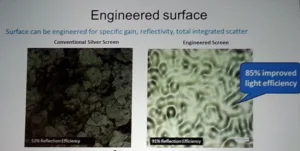RealD used the Technology Summit on Cinema to provide an update on development of its Ultrascreen technology, which also included the first public demo of its new screen technology showing 4k content from an RGB laser projector. The company was careful to note that this is still an “alpha” product, which means manufacturing methods must still be validated. But it was still good enough to produce great images and help RealD garner some feedback on the technology.
The basis of the Ultimate screen is “engineered structures”. RealD, along with licensees Harkness and MDI, has already produced a kind of hybrid screen using these engineered particles mixed in paint that can be sprayed on a vinyl surface. This is called the Premium White Screen.
The Ultimate Screen represents a departure from conventional screen manufacture. For very large cinema screens for example, the vinyl screen is often spray coated in the theater. This material and process also limits the size of the perforations in the screen, which are needed to allow sound through the screen. Ideally, smaller holes are better to minimize light loss.
The Ultimate screen technology is manufactured on a polymer substrate in roll-to-roll process. A proprietary diffusion pattern is embossed onto the plastic substrate, which is then metallized to produce the reflective surface. Panels of this screen material are then joined together to create the final Ultimate Screen. The Ultimate screen has an 85% improvement in light reflecting efficiency compared to a conventional silver screen, says RealD. It also allows the use of laser drilled perforations that are very small.
The Ultimate screen is not quite ready for production, but will be offered in two screen gains (2.2 and 3.0) that offer half gain angles of 36 and 28 degrees and a stereo contrast ratio of >300: and >400:1. That compares very favorably to standard silver screens that offer 2.4 and 2.9 gain with 24 and 20 degree half gain angles and stereo contrast levels of <100:1
RealD says that speckle reduction can be easily accomplished using small vibrators on the screen, although some laser projectors may not need this. This could be a very important new product for RealD and the industry.
In a talk, former Harkness Screen employee, Keith Watanabe said that there’s a bit of a disconnect in the type of screens that exhibitors are buying and what makes money. After doing some research, he said that the top 50 films represent 70% of industry revenue and of these films, 82% of the revenue came from films that were released in the wide aspect (2.35:1) Scope format while only 18% of the revenue came from films released in the Flat (1.85:1) format.
However, in looking at what two major exhibitor chains have purchased in the last 5 years, he found that the average screen aspect ratio was around 1.92:1, or heavily skewed toward the Flat format. He suggested that part of this may be explained in the Premium Large Format space as exhibitors wanting to have an “IMAX effect” of a large, very tall screen.
He suggested that maybe exhibitors should “follow the money” and install more Scope screens. – Chris Chinnock

